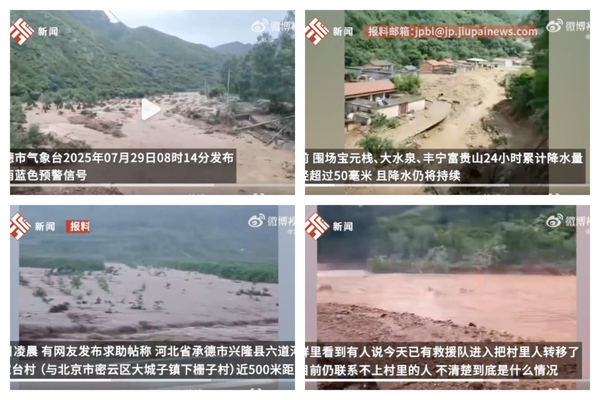Recent days, there have been continuous heavy rains in the northern region of China, resulting in severe disasters in Beijing, Hebei, and Inner Mongolia. On July 29th, parts of Xinglong County in Hebei Province experienced power outages and communication disruptions due to the heavy rain. The entire town of Liudaohe lost signal on their mobile phones, with Yangjiatai Village suffering from mudslides where all villagers could not be reached. Many netizens reported that not only Liudaohe Town but several villages and towns experienced power outages and communication disruptions.
In recent days, Xinglong County in Chengde experienced two rounds of heavy rain within three days. Around 2 a.m. on the 28th, a red rainstorm warning was once again issued in the area. The rain caused road closures and disruptions in power supply and communication in some areas.
Early morning on July 29th, a netizen posted a plea for help on social media, stating that in Yangjiatai Village, Liudaohe Town, Xinglong County, Hebei Province, significant flooding and mudslides had occurred, resulting in road closures, power outages, and communication disruptions, with casualties reported. Around 100 villagers were trapped but unable to be evacuated, leading to the call for assistance.
On the morning of the 29th, reporters attempted to contact several villagers in Liudaohe Town, but all their phones were switched off. The same netizen who posted the plea for help informed the reporter that many villages in Liudaohe Town were facing similar situations. Emergency response teams had been dispatched for rescue operations, although contact was difficult due to disrupted communication networks.
Due to the signal disruptions, there was temporary difficulty in establishing contact with the rescue teams. An official from the local emergency management department noted that the heavy rainfall had caused widespread power outages and communication failures in some towns and villages within their jurisdiction.
Subsequently, the disaster in Xinglong County garnered widespread attention on social media platforms. Residents shared their experiences of the unprecedented flooding, road closures, power outages, and signal disruptions, making it challenging for people to evacuate affected areas.
Netizens voiced concerns about the disconnected villages and towns, highlighting the urgency of the situation and pleading for prompt assistance and reconnection. The severity of the situation was emphasized by reports of essential infrastructure like water supply systems being damaged, leading to a widespread lack of access to clean drinking water in some disaster-stricken regions.
In light of the ongoing challenges, residents and authorities continued efforts to restore essential services, repair damaged infrastructure, and ensure the safety and well-being of those affected by the natural disaster. The situation remained fluid, with ongoing communication hurdles complicating rescue and relief efforts.
As the region grappled with the aftermath of the heavy rainfall and subsequent disasters, the resilience and cooperation of the affected communities were crucial in navigating the crisis and rebuilding their lives in the face of adversity.

